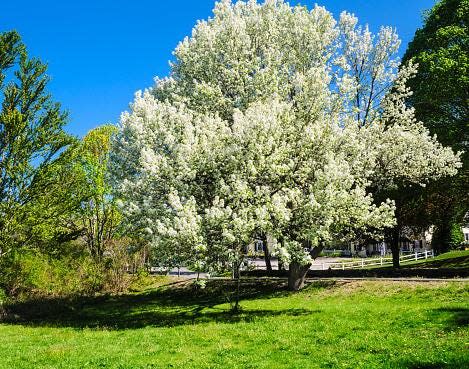Love in the time of Callery: Bradford pear tree wreaks ecological havoc in South Carolina

It was love at first sight with the Bradford pear tree. Lollipop-shaped and beautiful year-round, its white flowers are among the fist signs of spring in South Carolina.
Landowners across the state settled down with sweet saplings, but sparks faded when the tree's delicate blooms saturated yards with a stench often compared to that of dead fish.
It may be nice to look at, but the negative effects of the Bradford pear tree are becoming more evident, according to David Coyle, a professor at Clemson University who leads a program to eradicate the tree in South Carolina.
"Anyone who's willing to listen and willing to learn, we're gonna tell them why this tree is a bad idea," he said.
Bradford pear is not 'just a tree'
The Bradford pear tree was supposed to be the perfect lawn ornament, and was planted all over the eastern U.S. the 1960's. It is a cultivar of pyrus calleryana, or the Callery pear, which means the Bradford pear was bred from the Callery pear to have specific desired traits, Coyle said.
Once the perfect tree had been created, it was essentially cloned over and over by grafting it onto root systems of other trees of the same species. This means that in each Bradford pear tree there are technically two genetically different individual plants — one on top and one on the bottom.
What can you do? It's being banned, killed with fire and there's a bounty. How to stop the Bradford Pear
"Tops of Bradfords are all the same genetically," Coyle said. "The roots of Bradfords are not the same."
This was supposed to make the Bradford pear tree sterile because the top of every tree was genetically identical to every other tree, and two identical individuals can't reproduce together.
But at the root of the Bradford pear tree is an invasive Callery pear, and those were able to cross-pollinate with each other, leading to an outbreak of Callery pears. The trees grow in clusters, creating thick canopies close to the ground that crowd out native flora.
"Think of it like a wild Bradford pear that's out of control at this point," Coyle said.
One of the reasons Bradfords became so popular is because few insects feed upon them, Coyle said. This may seem like a positive, but it turns wooded areas into food deserts for wildlife who feed on those insects.
From the Archive: The Curse of the Bradford Pear
With its deep-V trunk, the tree is also structurally flawed, making it a hazard to have near roads, powerlines and other infrastructure.
Ending the relationship is no easy feat. Wild Callery pears grow in dense groups and have large thorns that routinely pop tractor tires, Coyle said.
"After about a year when you can no longer cut them down with a bushhog or a big mower or something, it becomes really, really hard to get them off your property," Coyle said.
Bradford Pear Bounty
Inspired by similar programs in Arkansas and Missouri, the Bradford Pear Bounty program is a collaboration between Clemson Extension and the South Carolina Forestry Commission that gives away free trees to people who cut down their Bradford pear tree.
So far, the program has replaced about 1,200 trees.
The first giveaway was in 2020, and people were asked to bring proof of their Bradford's demise, via contractor paperwork or a selfie with the cut down tree, and they would receive a replacement tree that is better for the environment.
Three giveaways were planned for 2022, each occurring in a different city to make the program accessible to people across South Carolina. There was one giveaway in Sumter on Feb. 26, one in Conway on March 5 and another is scheduled on March 19 in Clemson.
The replacement trees are either purchased by the local municipality or with donations. There are about 250 trees at each event, which costs about $2,500 to $3,000.
None of the money goes to waste, Coyle said.
"So far, every tree we've purchased has been planted somewhere."
Here's what you can do: Alternatives to Bradford Pear Trees
Bradford pear vs. Dogwood: Other fish in the sea
There's a whole forest of more suitable trees, like dogwood, various oaks, and more. At each giveaway, Coyle and the others working the event try to help everyone find "the one" by asking what they're looking for in a tree.
“We work with all the landowners to try to get them the right tree for what they’re after," Coyle said.
There's no telling how many Bradford and Callery pear trees are out there, and Coyle knows they'll probably never get them all — there's just too many.
"But there's a lot to be said for educating our citizens about the benefits of planting native species," Coyle said. "We can teach people to make better choices when it comes to their own property and landscaping."
This article originally appeared on Greenville News: As Bradford pear blooms, steps taken to eradicate invasive, pesky tree
